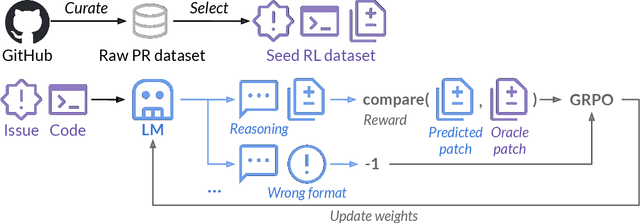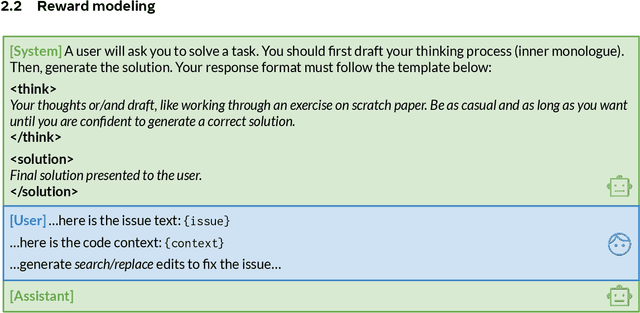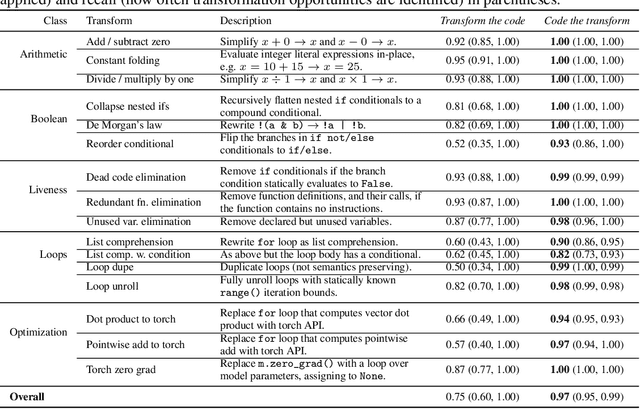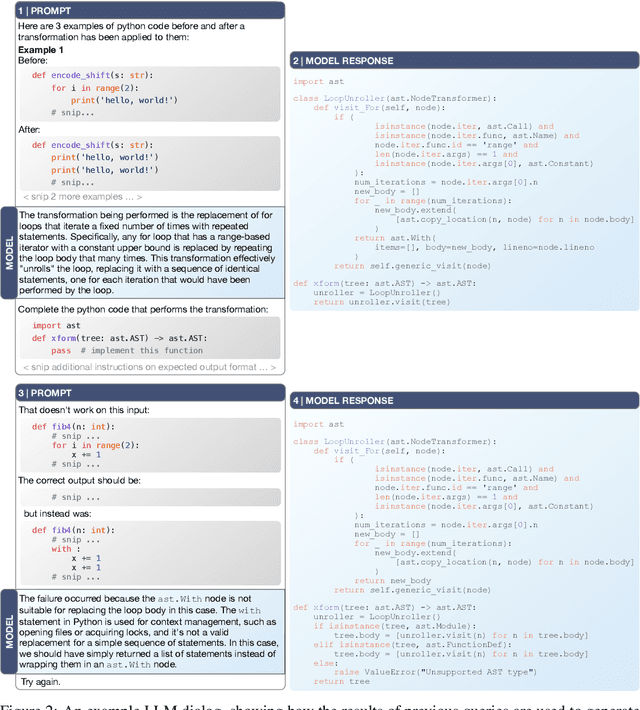Gabriel Synnaeve
Jack
Stochastic activations
Sep 26, 2025Abstract:We introduce stochastic activations. This novel strategy randomly selects between several non-linear functions in the feed-forward layer of a large language model. In particular, we choose between SILU or RELU depending on a Bernoulli draw. This strategy circumvents the optimization problem associated with RELU, namely, the constant shape for negative inputs that prevents the gradient flow. We leverage this strategy in two ways: (1) We use stochastic activations during pre-training and fine-tune the model with RELU, which is used at inference time to provide sparse latent vectors. This reduces the inference FLOPs and translates into a significant speedup in the CPU. Interestingly, this leads to much better results than training from scratch with the RELU activation function. (2) We evaluate stochastic activations for generation. This strategy performs reasonably well: it is only slightly inferior to the best deterministic non-linearity, namely SILU combined with temperature scaling. This offers an alternative to existing strategies by providing a controlled way to increase the diversity of the generated text.
Set Block Decoding is a Language Model Inference Accelerator
Sep 04, 2025Abstract:Autoregressive next token prediction language models offer powerful capabilities but face significant challenges in practical deployment due to the high computational and memory costs of inference, particularly during the decoding stage. We introduce Set Block Decoding (SBD), a simple and flexible paradigm that accelerates generation by integrating standard next token prediction (NTP) and masked token prediction (MATP) within a single architecture. SBD allows the model to sample multiple, not necessarily consecutive, future tokens in parallel, a key distinction from previous acceleration methods. This flexibility allows the use of advanced solvers from the discrete diffusion literature, offering significant speedups without sacrificing accuracy. SBD requires no architectural changes or extra training hyperparameters, maintains compatibility with exact KV-caching, and can be implemented by fine-tuning existing next token prediction models. By fine-tuning Llama-3.1 8B and Qwen-3 8B, we demonstrate that SBD enables a 3-5x reduction in the number of forward passes required for generation while achieving same performance as equivalent NTP training.
Don't Overthink it. Preferring Shorter Thinking Chains for Improved LLM Reasoning
May 23, 2025Abstract:Reasoning large language models (LLMs) heavily rely on scaling test-time compute to perform complex reasoning tasks by generating extensive "thinking" chains. While demonstrating impressive results, this approach incurs significant computational costs and inference time. In this work, we challenge the assumption that long thinking chains results in better reasoning capabilities. We first demonstrate that shorter reasoning chains within individual questions are significantly more likely to yield correct answers - up to 34.5% more accurate than the longest chain sampled for the same question. Based on these results, we suggest short-m@k, a novel reasoning LLM inference method. Our method executes k independent generations in parallel and halts computation once the first m thinking processes are done. The final answer is chosen using majority voting among these m chains. Basic short-1@k demonstrates similar or even superior performance over standard majority voting in low-compute settings - using up to 40% fewer thinking tokens. short-3@k, while slightly less efficient than short-1@k, consistently surpasses majority voting across all compute budgets, while still being substantially faster (up to 33% wall time reduction). Inspired by our results, we finetune an LLM using short, long, and randomly selected reasoning chains. We then observe that training on the shorter ones leads to better performance. Our findings suggest rethinking current methods of test-time compute in reasoning LLMs, emphasizing that longer "thinking" does not necessarily translate to improved performance and can, counter-intuitively, lead to degraded results.
Optimizing Language Models for Inference Time Objectives using Reinforcement Learning
Mar 25, 2025Abstract:In this work, we investigate the merits of explicitly optimizing for inference time algorithmic performance during model training. We show how optimizing for inference time performance can improve overall model efficacy. We consider generic inference time objectives with $k$ samples, with a focus on pass@$k$ and majority voting as two main applications. With language model training on reasoning datasets, we showcase the performance trade-off enabled by training with such objectives. When training on code generation tasks, we show that the approach significantly improves pass@$k$ objectives compared to the baseline method.
BigO(Bench) -- Can LLMs Generate Code with Controlled Time and Space Complexity?
Mar 20, 2025Abstract:We introduce BigO(Bench), a novel coding benchmark designed to evaluate the capabilities of generative language models in understanding and generating code with specified time and space complexities. This benchmark addresses the gap in current evaluations that often overlook the ability of models to comprehend and produce code constrained by computational complexity. BigO(Bench) includes tooling to infer the algorithmic complexity of any Python function from profiling measurements, including human- or LLM-generated solutions. BigO(Bench) also includes of set of 3,105 coding problems and 1,190,250 solutions from Code Contests annotated with inferred (synthetic) time and space complexity labels from the complexity framework, as well as corresponding runtime and memory footprint values for a large set of input sizes. We present results from evaluating multiple state-of-the-art language models on this benchmark, highlighting their strengths and weaknesses in handling complexity requirements. In particular, token-space reasoning models are unrivaled in code generation but not in complexity understanding, hinting that they may not generalize well to tasks for which no reward was given at training time.
The KoLMogorov Test: Compression by Code Generation
Mar 18, 2025Abstract:Compression is at the heart of intelligence. A theoretically optimal way to compress any sequence of data is to find the shortest program that outputs that sequence and then halts. However, such 'Kolmogorov compression' is uncomputable, and code generating LLMs struggle to approximate this theoretical ideal, as it requires reasoning, planning and search capabilities beyond those of current models. In this work, we introduce the KoLMogorov-Test (KT), a compression-as-intelligence test for code generating LLMs. In KT a model is presented with a sequence of data at inference time, and asked to generate the shortest program that produces the sequence. We identify several benefits of KT for both evaluation and training: an essentially infinite number of problem instances of varying difficulty is readily available, strong baselines already exist, the evaluation metric (compression) cannot be gamed, and pretraining data contamination is highly unlikely. To evaluate current models, we use audio, text, and DNA data, as well as sequences produced by random synthetic programs. Current flagship models perform poorly - both GPT4-o and Llama-3.1-405B struggle on our natural and synthetic sequences. On our synthetic distribution, we are able to train code generation models with lower compression rates than previous approaches. Moreover, we show that gains on synthetic data generalize poorly to real data, suggesting that new innovations are necessary for additional gains on KT.
Soft Policy Optimization: Online Off-Policy RL for Sequence Models
Mar 07, 2025

Abstract:RL-based post-training of language models is almost exclusively done using on-policy methods such as PPO. These methods cannot learn from arbitrary sequences such as those produced earlier in training, in earlier runs, by human experts or other policies, or by decoding and exploration methods. This results in severe sample inefficiency and exploration difficulties, as well as a potential loss of diversity in the policy responses. Moreover, asynchronous PPO implementations require frequent and costly model transfers, and typically use value models which require a large amount of memory. In this paper we introduce Soft Policy Optimization (SPO), a simple, scalable and principled Soft RL method for sequence model policies that can learn from arbitrary online and offline trajectories and does not require a separate value model. In experiments on code contests, we shows that SPO outperforms PPO on pass@10, is significantly faster and more memory efficient, is able to benefit from off-policy data, enjoys improved stability, and learns more diverse (i.e. soft) policies.
SWE-RL: Advancing LLM Reasoning via Reinforcement Learning on Open Software Evolution
Feb 25, 2025



Abstract:The recent DeepSeek-R1 release has demonstrated the immense potential of reinforcement learning (RL) in enhancing the general reasoning capabilities of large language models (LLMs). While DeepSeek-R1 and other follow-up work primarily focus on applying RL to competitive coding and math problems, this paper introduces SWE-RL, the first approach to scale RL-based LLM reasoning for real-world software engineering. Leveraging a lightweight rule-based reward (e.g., the similarity score between ground-truth and LLM-generated solutions), SWE-RL enables LLMs to autonomously recover a developer's reasoning processes and solutions by learning from extensive open-source software evolution data -- the record of a software's entire lifecycle, including its code snapshots, code changes, and events such as issues and pull requests. Trained on top of Llama 3, our resulting reasoning model, Llama3-SWE-RL-70B, achieves a 41.0% solve rate on SWE-bench Verified -- a human-verified collection of real-world GitHub issues. To our knowledge, this is the best performance reported for medium-sized (<100B) LLMs to date, even comparable to leading proprietary LLMs like GPT-4o. Surprisingly, despite performing RL solely on software evolution data, Llama3-SWE-RL has even emerged with generalized reasoning skills. For example, it shows improved results on five out-of-domain tasks, namely, function coding, library use, code reasoning, mathematics, and general language understanding, whereas a supervised-finetuning baseline even leads to performance degradation on average. Overall, SWE-RL opens up a new direction to improve the reasoning capabilities of LLMs through reinforcement learning on massive software engineering data.
Don't Transform the Code, Code the Transforms: Towards Precise Code Rewriting using LLMs
Oct 11, 2024



Abstract:Tools for rewriting, refactoring and optimizing code should be fast and correct. Large language models (LLMs), by their nature, possess neither of these qualities. Yet, there remains tremendous opportunity in using LLMs to improve code. We explore the use of LLMs not to transform code, but to code transforms. We propose a chain-of-thought approach to synthesizing code transformations from a small number of input/output code examples that incorporates execution and feedback. Unlike the direct rewrite approach, LLM-generated transformations are easy to inspect, debug, and validate. The logic of the rewrite is explicitly coded and easy to adapt. The compute required to run code transformations is minute compared to that of LLM rewriting. We test our approach on 16 Python code transformations and find that LLM- generated transforms are perfectly precise for 7 of them and less imprecise than direct LLM rewriting on the others. We hope to encourage further research to improving the precision of LLM code rewriting.
What Makes Large Language Models Reason in (Multi-Turn) Code Generation?
Oct 10, 2024



Abstract:Prompting techniques such as chain-of-thought have established themselves as a popular vehicle for improving the outputs of large language models (LLMs). For code generation, however, their exact mechanics and efficacy are under-explored. We thus investigate the effects of a wide range of prompting strategies with a focus on automatic re-prompting over multiple turns and computational requirements. After systematically decomposing reasoning, instruction, and execution feedback prompts, we conduct an extensive grid search on the competitive programming benchmarks CodeContests and TACO for multiple LLM families and sizes (Llama 3.0 and 3.1, 8B, 70B, 405B, and GPT-4o). Our study reveals strategies that consistently improve performance across all models with small and large sampling budgets. We then show how finetuning with such an optimal configuration allows models to internalize the induced reasoning process and obtain improvements in performance and scalability for multi-turn code generation.
 Add to Chrome
Add to Chrome Add to Firefox
Add to Firefox Add to Edge
Add to Edge